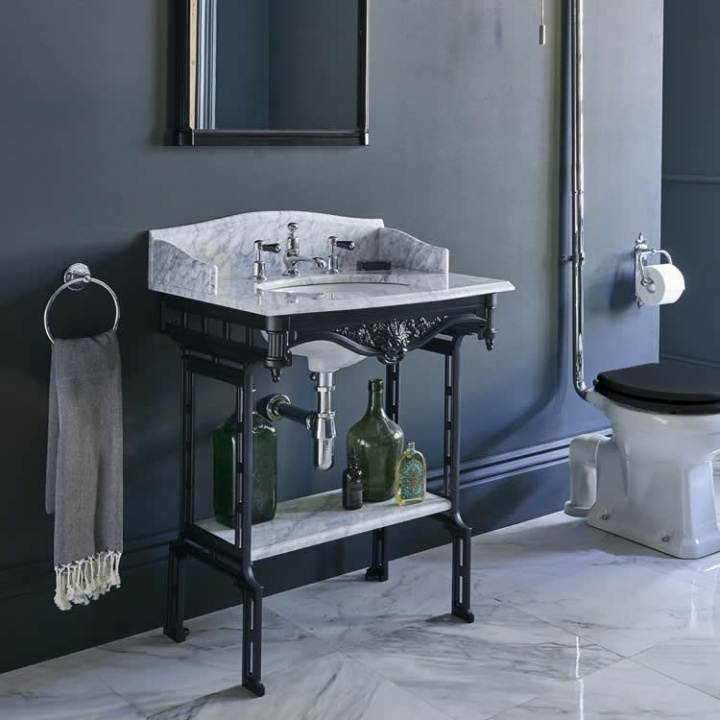In the world of period-inspired bathrooms, the classical Georgian style is hard to beat. When done properly, Georgian bathrooms are bright, airy and perfectly laid out, infused with a subtle elegance that quietly impresses without overwhelming. If you’re interested in creating your very own Georgian bathroom paradise, we’ve compiled this comprehensive guide to get you up and running.
So, Who Exactly Were The Georgians and When Were They Knocking About?
The Georgian era kicked off in 1714, when George I of Hannover found his way onto the British throne. He was then followed by a steady stream of subsequent Georges over the next century or so, ending with the death of George IV in 1830. This particular George was succeeded by his younger brother, William IV, who was notably not called George. However, his reign is still considered Georgian by many historians (presumably because it sounds better than ‘Williamian’). The Georgian period ceased definitively in 1837, marked by the ascension of Queen Victoria.
The Georgian age was a time of industrialism, rationalism, colonialism, and various other notable isms. It’s characterised by scientific discoveries, romantic poetry, flowery novels, economic expansion and endless wars with France. It was also an age of high aesthetics and unparalleled beauty through art, architecture and interior design, which is what we’ll be focusing on today.
Did Georgian Homes Even Have Bathrooms?
The short answer is no. It’s impossible to create a truly authentic Georgian bathroom, as they didn’t actually exist. The idea of the bathroom as its own space didn’t really take off until well into the Victorian age, helped considerably by the advent of things like hot water pipes and indoor plumbing. Most Georgians, rich and poor alike, simply washed in their own bedrooms using a basin of water.
A full body wash was usually only undertaken every one or two weeks. Baths were sometimes enjoyed by wealthier people, but not as we know them today. They were usually taken lukewarm and partially clothed for starters, as the Georgians believed that soaking naked in hot water allowed disease to enter the body.
What About Toilets?
While early versions of flushing toilets did exist in the Georgian era, they were impractical, smelly and hardly ever used. Alexander Cumming patented the first modern flushing toilet in 1795, inventing the S-bend to solve the problem of foul gasses spewing up from the sewer. Even then, flushing toilets still didn’t become widespread until the middle of the 19th century. When nature called, Georgian people either used a chamber pot or waddled outside to visit the outhouse.
What Does This Mean For My Georgian-style Bathroom?
While you can’t create a true-to-life Georgian bathroom (nor would you want to, based on the above), you can utilise the unique architecture and aesthetics of the era to inspire your bathroom space. Let’s get cracking!
What Defines Georgian Style?
Georgian style encompassed a wide range of aesthetic movements and architectural trends, which we’ll examine more closely in a sec. Broadly speaking, designs were based around restraint, sensible taste and simple, unobtrusive elegance. Think pleasing symmetry, smart geometry and subtle, balanced shapes, particularly towards the end of the period. Colours ranged from rich, striking hues in the early 18th century to muted pastel shades from the 1750s onwards, with mauve, pink and pea green becoming popular as the years wore on.
Georgian designers drew from a wide range of sources, from Asian culture to French baroque to the classical world of Ancient Greece and Rome. Here’s a quick summary:
Early Georgian Style
The first few Georgian decades were characterised by the lingering influence of the baroque style, as well as related schools such as rococo and chinoiserie (more on those later). Deep, opulent colours like burgundy and sage green could be found in many rooms, often painted over wooden panelling that stretched from floor to ceiling.
‘Rococo’ was in vogue from the early-to-mid 1700s, which consisted of lavish, extravagant designs often derived from nature. Known as ‘the French taste’, this style encompassed everything from architecture to furniture, and was known for its wild, asymmetrical designs and complex natural motifs (waves, leaves, birds, shells, etc). Rococo was adventurous, outlandish and slightly bonkers, aiming to blow the beholder away through sheer visual power.
The chinoiserie style was a kind of Asian-inspired subsect of rococo. It shared the garish designs and marvellous complexities, using the then-exotic continent of Asia as its main theme. Intricately painted ceramic tea sets were common, as were Asian-infused furnishings and murals depicting scenes from Chinese and Japanese life. Chinoiserie coincided with the growing availability of wallpaper, with whole rooms often decked out in stunning, hand-painted representations of exotic birds and patterns.
Later Georgian and Neoclassical
By the middle of the 18th century, things had taken a dramatic turn. The discovery of the ruins of Pompeii in 1748 sparked a frenzy of interest in the classical world. Almost immediately, Ancient Greek and Roman influences began seeping into architecture and interior design, quickly becoming the predominant visual style of the Georgian era.
Order and symmetry took over from the unfettered visual complexity of rococo, with designers becoming almost obsessive in their attempts to accurately recreate Greek columns and Roman alcoves. From newly commissioned churches to sprawling stately homes, the neoclassical style could be found almost everywhere before too long.
Busts and statues depicting gods or heroes were popular accessories, as were vases and urns adorned with the Greek key pattern. Striped wallpaper brought the neat, symmetrical look inside, while ornate plastered ceilings became striking features of wealthier homes. Colours grew paler and more subdued, copied from surviving samples of Roman paint. Pastel greens, blues and peaches were prevalent, overtaking the bolder, more demanding colours enjoyed previously.
The theme of classical elegance eschewed the wild extravagances of the previous decades. However, as we’ll soon see, these things have a way of coming back around.
Regency Style
The Regency era was a subperiod that occurred towards the end of the wider Georgian era. It’s named after the Regency Act of 1811, when George III became too ill to rule and his son, the future George IV, assumed his royal duties as the Prince Regent.
Stylistically, the Regency represented the culmination of everything that came before. The whimsical, bombastic flourishes of the early Georgian years began to seep back into the neoclassical revival. Designers and craftsmen became less slavishly devoted to the ancient masters, forgoing obsessive accuracy and introducing personal flair back into the proceedings. Richer colours such as Pompeii red and emerald green began to offset the muted pastels once more, while walls became adorned with mahogany wood, brass accents and decadent wallpapers.
Ancient Egypt also found itself the subject of Regency focus. Napoleon’s 1798 invasion of the country inadvertently started the ‘Egyptomania’ craze, which would stretch on into the next century and beyond. Pyramids, obelisks and sphynxes became prominent, with depictions of Egyptian gods and hieroglyphics also featuring heavily in home décor.
The broad themes of symmetry and order remained dominant during the Regency. However, the gradual introduction of brighter colours, bolder patterns and more whimsical ornamentation paved the way for the eccentric mishmash of styles that went on to define the Victorian age.
Georgian Cottage and Georgian Farmhouse
Georgian-style bathrooms tend to take their cues from the country cottages and ‘dolls house’ farmhouses of the 18th century. Spacious, smartly shaped and crafted with satisfying symmetry, authentic Georgian country homes continue to be highly sought after even today.
The uncomplicated square rooms of Georgian houses are often considered their secret weapon. Their simple layout means that a vast number of decorative features can be added without becoming too busy or cluttered, making these rooms highly malleable in terms of interior design. This is well worth remembering when it comes to your own bathroom renovation.
Another defining element is the large windows, often in the bold sash style. These windows are designed to flood the room with warm, natural light, and they pair well with period-inspired wooden shutters. If your bathroom includes an outside wall, installing an authentic Georgian sash window is a sure-fire way to help it look the part.
Modern/Neo-Georgian & Federal style
‘Modern’ or ‘Neo-Georgian’ refers to attempts to recreate Georgian architecture in subsequent eras. It started in the 20th century, with Georgian works having been previously dismissed by the Victorians as “sordid and degenerate” (much how the classical acolytes of the Georgian age thought Stuart trends were “theatrical, exuberant and Catholic”).
The geometric simplicity and symmetrical nature of Georgian buildings held the key to their renewed appeal. They were easy to replicate and cheap to construct, offering a stylish way to create elegant buildings without having to faff about with gothic spires or baroque cartouches (whatever those are). Again, this uncomplicated appeal is what makes Georgian bathrooms such a popular choice today; it allows the creation of gorgeous period interiors without the need for anything too fancy or outlandish.
Lastly, the Federal style developed as more of a reaction against Georgian ideals than a direct continuation of it. Federal originated in the newly formed United States of America in the years following the Revolutionary War. Having finally broken free of George III’s rule, the American people were understandably not that keen on building houses in the style named after his dynasty.
The Federal look emerged as something of a stripped-down version of neoclassical Georgian. It kept the symmetry and geometrics, but scaled back on the more elaborate stuff like flouncy wallpaper and ornately plastered ceilings. Federal homes are recognisable for their heavy use of wooden panelling, elliptical fanlights and striking Palladian windows.
Why is the Georgian Style Such A Popular Choice in Bathroom Design?
People love Georgian bathrooms for a variety of reasons. They hark back to a romanticised image of an era famous for its grace and beauty, evoking nostalgic feelings for a time we could never otherwise experience. A Georgian bathroom represents your own little window to a bygone age, transporting you back to the green, sparkling world of Jane Austin, Lord Byron and rampant smallpox. Wait, never mind that last one.
Another big plus is the ease of creation. If you stick to the timeless Georgian principals of restraint, symmetry and sleek geometrics, you can put together a fabulous period-accurate bathroom with minimal fuss. The Georgian look holds great appeal for those who enjoy both subtlety and classical stylings. It combines the old-fashioned glamour of the Victorians and the minimalism of the Edwardians, whilst simultaneously forgoing the loudness of the former and the modernity of the latter. In other words, you get the best of both worlds!
How to Decorate Your Bathroom in a Georgian Style
Now we’ve traversed the complex history and diverse aspects of Georgian aesthetics, it’s time to examine how you can use them to bring your own 18th-century bathroom sanctuary to life.
Georgian Décor
As we’ve established, interior décor varies substantially depending on which chunk of the Georgian era you’re looking to ape. If you like the early Georgian style, you can start with rich, bold colours like the aforementioned burgundy and sage. These can be applied through either tiling or paintwork, comprising the entire theme or just a single feature wall. Richly painted tiles can help you recreate the complex patterns and motifs of the rococo and chinoiserie movements, as can vinyl wallpaper designed to withstand bathroom moisture.
If you prefer the later neoclassical or Regency look, black-and-white tiled flooring is a great little nod to stately Georgian mansions. Colours should be calming, matt-finished pastels, although the odd darker accent can never hurt (think back to the Pompeii red and emerald green of the Regency). Striped wallpaper, or tiles arranged into stripes, will also fit this theme splendidly, as will subtle nods to classical influences like mosaic tiles, Greek key or marble accents.
Whatever style you’re going for, certain elements are universally Georgian. For example, wood panel feature walls or flooring will never feel out of place, and neither will grey or red tiles that evoke the brick/stonework of Georgian farmhouses. Tall, airy windows can enhance the farmhouse or cottage chic, while low-voltage electrical lighting provides a warm, candle-like glow in the evenings.
Georgian Baths
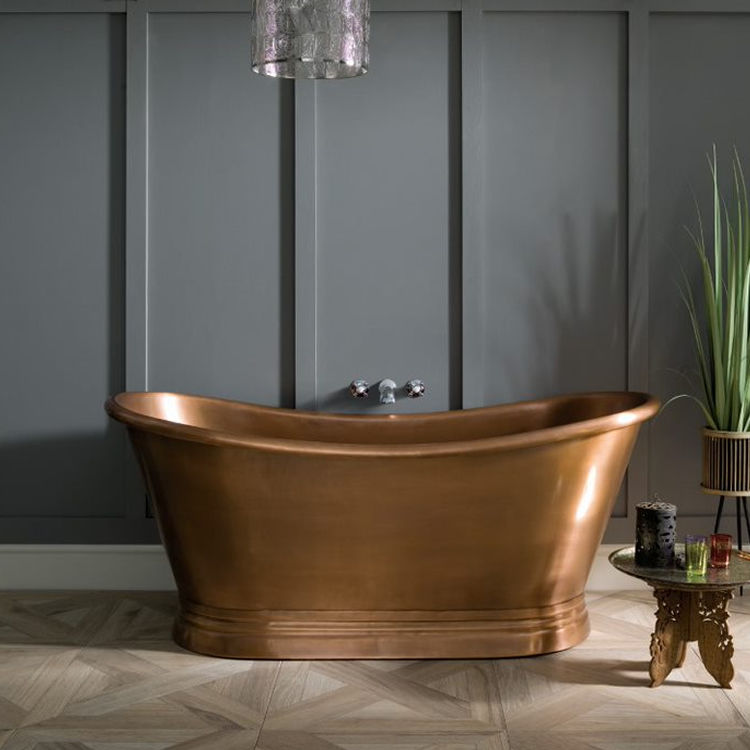
True Georgian bathtubs were essentially just metal tins, which is not ideal if you’re aiming for comfort and visual appeal. However, there are plenty of stunning traditional baths out there that perfectly capture the Georgian essence without the bruised back. A freestanding bath is the most striking choice, particularly a period-style boat bath with a roll top edge. Metallic finishes like steel, copper or gold can further add to the authenticity, creating an accurate representation of a Georgian bath with the benefits of modern luxury. The double-ended shape of boat baths also contributes to the theme of symmetry.
If your space doesn’t allow for a freestanding bath, or you just don’t like the look of them, a back-to-wall bath can be just as effective when combined with wood-effect bath panels. These can also be painted to better match your theme.
Georgian Basins
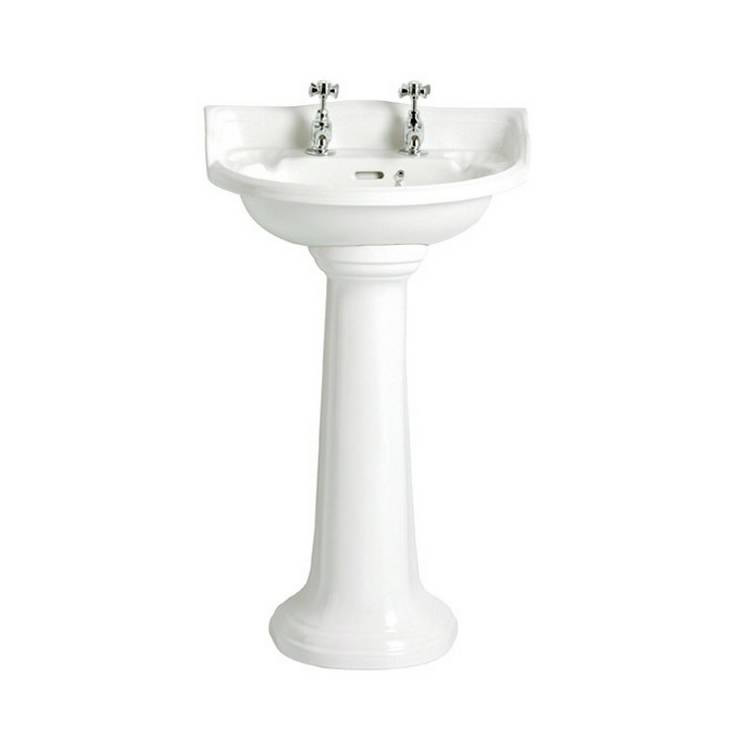
Most Georgians would’ve made do with a bowl or a bucket in place of an actual sink, but feel free to shoot a bit higher if that doesn’t quite do it for you. A traditional pedestal basin is an excellent choice for a Georgian bathroom, particularly one with ridged lines that resemble a Greek or Roman pillar. After all, you might not be able to fit a full Corinthian column inside your bathroom, but a well-proportioned pedestal is an excellent substitute.
The basin should be simple and curved, as the square shape is more of a Victorian thing. If you do prefer a square or rectangular sink, consider choosing a console basin or washstand with a pair of slender, subtly ornamented legs. Traditional wall-hung basins can also be used, and are often more viable for those creating smaller bathroom or cloakroom spaces.
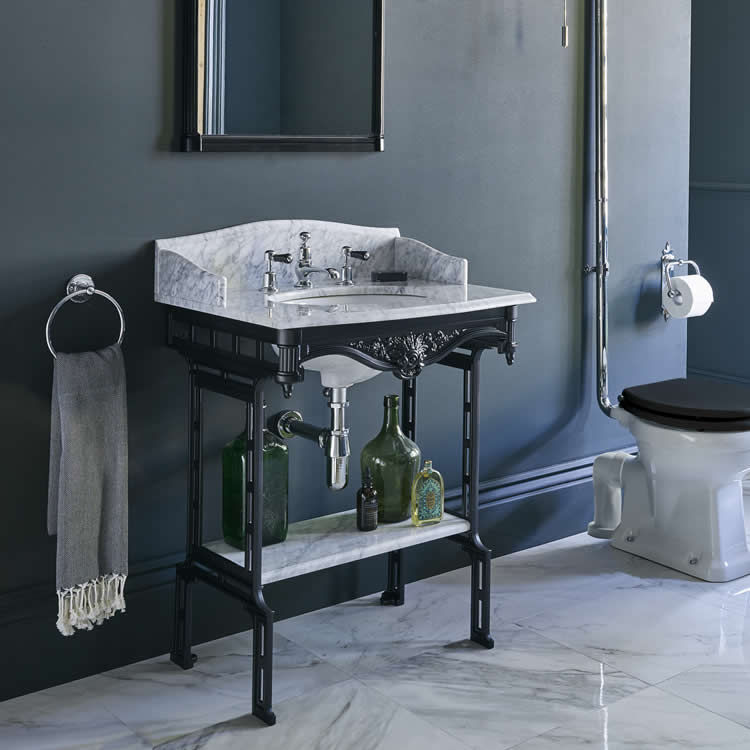
Georgian Taps
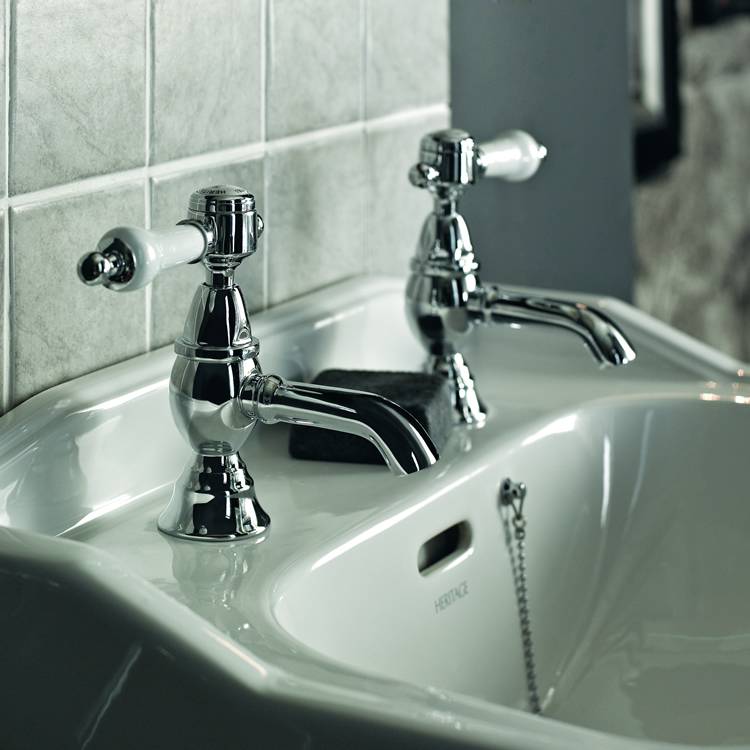
Again, there was no such thing as running water taps in Georgian days. Still, you’ll probably want them anyway, unless you’re extremely committed to authenticity (all power to you). Traditional basin pillar taps and bath pillar taps are the closest you can get, and we’d suggest going with ceramic lever handles as opposed to Victorian crosshead handles. As for the finish, anything metallic is great as long as it ties in with your wider décor.
If you have a freestanding bath, a slender, elegant floor-mounted bath tap is the perfect way to finish it off. Traditional deck-mounted bath fillers are another viable option, particularly those with a symmetrical bridged look. These types of taps often come with a shower handset and hose for added practical benefit.
Georgian Toilets
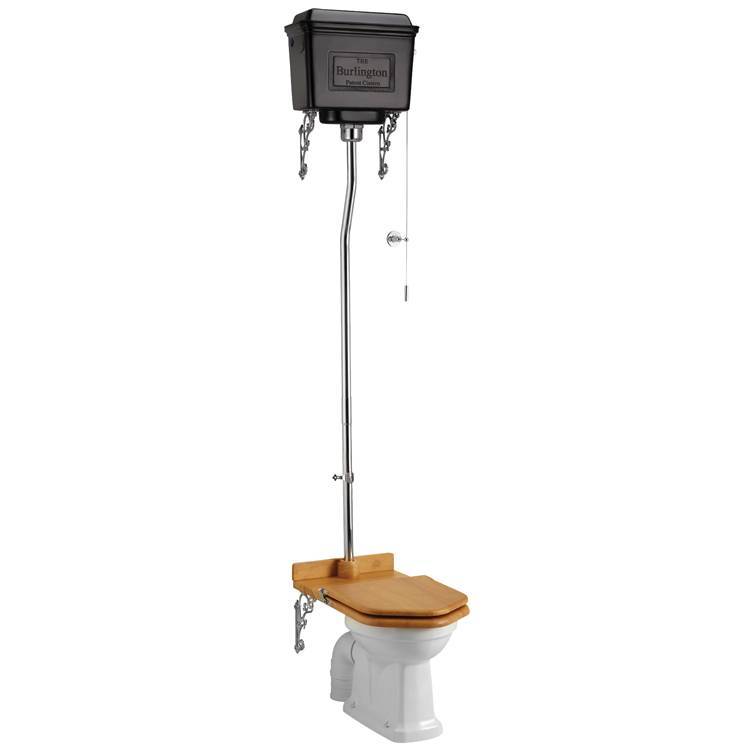
Unless you’re pining for the authentic chamber pot experience, a toilet should be reasonably high on your list of priorities. You’re pretty much free to use any traditionally designed toilet that blends well with your overall theme. Elevated cisterns work well for their old-timey charm, although again this is more of a Victorian feature. Even so, it will still work conceptually and stylistically with the rest of your Georgian interior.
Consider a wood-effect toilet seat to match your panelling or flooring, while a ridged base can emulate ancient columns in a similar manner to your basin’s pedestal.
Georgian Showers
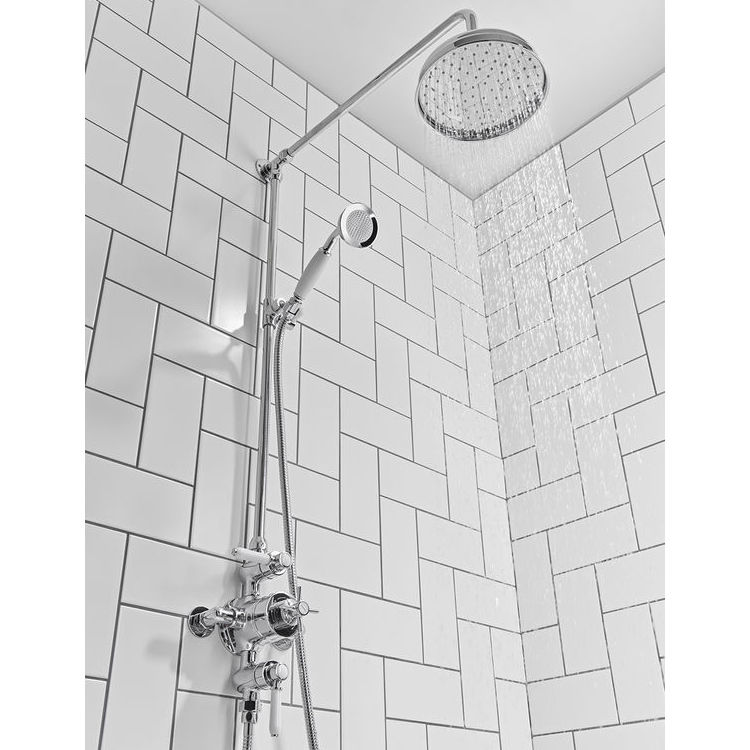
Just like with toilets, there’s really no such thing as a Georgian shower. Again, this gives you plenty of room for manoeuvre when choosing your preferred model. Just keep in mind the basic tenants of symmetry and decorative subtlety, and ensure that your chosen shower system suits the rest of your brassware in terms of metallic finish and ceramic accents.
There’s a wealth of period-inspired shower options out there, ranging from riser rail kits with adjustable handsets to wall/ceiling-mounted rainfall shower heads. To be honest, the shower isn’t that important in establishing your Georgian theme in comparison to more ornate fixtures like the basin or bath. As long as it matches everything else, you should be just fine.
Georgian Furniture & Accessories
Wooden furniture was a universal feature of Georgian interiors, and sticking some in is a handy shortcut to achieving authenticity. Winged or hoop-backed chairs are both great shouts, instantly suggesting elegant Georgian sensibilities. A wide array of restrained, gorgeously designed traditional vanity units are available, which can be fitted with either matching worktops or inset basins. You can even make your own by mounting a marble-effect worktop onto an antique cabinet or chest of drawers. Wooden fixings can be sprayed with water-resistant varnish, so don’t worry about getting them wet.
As for ornamentation, there’s a huge array of options out there limited only by your imagination. If you’re going for a neoclassical theme, try dotting a few Greek-style vases about. These can be left empty or filled with plants, both real and artificial. Framed prints of 18th-century artworks from the likes of John Constable, Thomas Gainsborough and William Blake will add a classy flourish, particularly if the frames themselves are decorated in the gilded rococo or more subdued Palladian style. Bathroom mirrors with similarly decorative frames are also well worth considering.
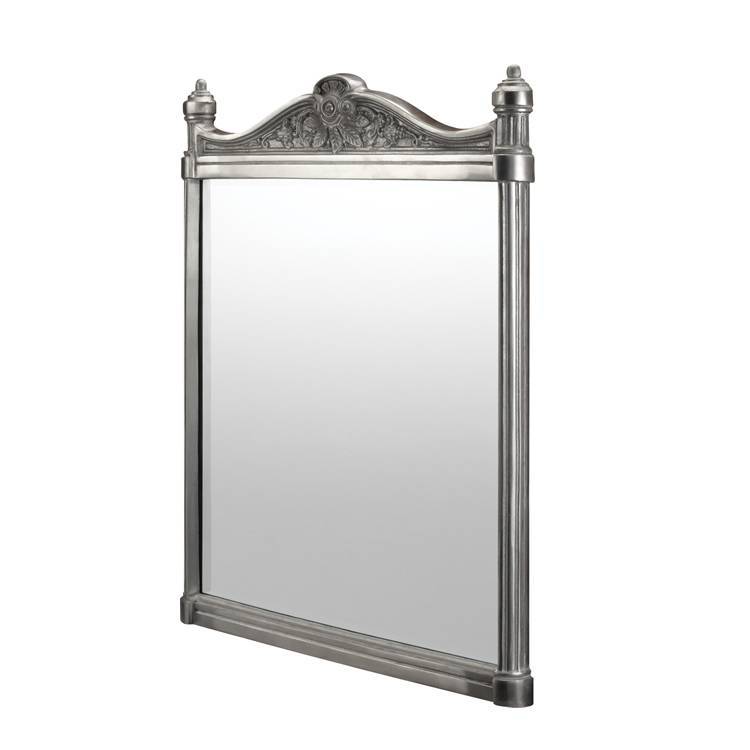
Striped fabric is another easy Georgian embellishment, with options such as rugs, towels and bathmats readily available. Trefoils, carnations and other floral patterns can also be used, as can more exotic Asian motifs as a nod to the chinoiserie trend. The possibilities are endless!
Images of Georgian Bathrooms
So, now that we’ve seen how wonderful and varied Georgian bathrooms can be, we bet you can’t wait to get started on creating your very own. Why not browse our website for some more inspiration? You can also contact our team with any questions you might have, while our 3D bathroom design service will let you bring your vision to life without lifting a finger. Our Leeds showroom is ready and waiting if you fancy popping in for a face-to-face chat, so don’t be shy about getting in touch.
